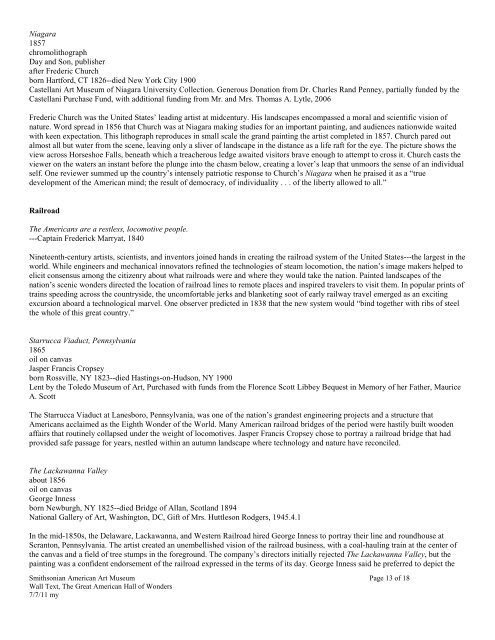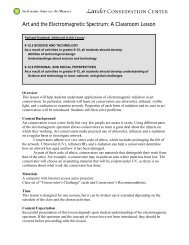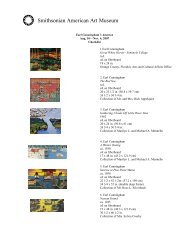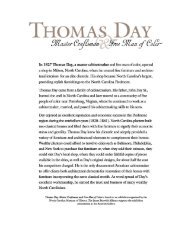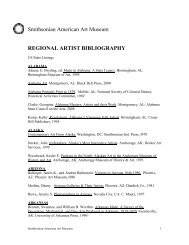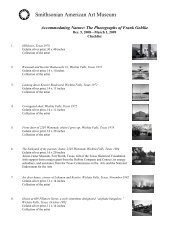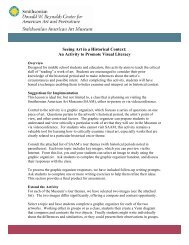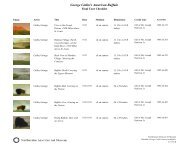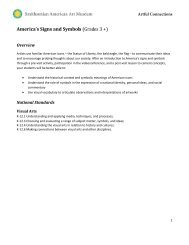Smithsonian American Art Museum - Smithsonian Institution
Smithsonian American Art Museum - Smithsonian Institution
Smithsonian American Art Museum - Smithsonian Institution
Create successful ePaper yourself
Turn your PDF publications into a flip-book with our unique Google optimized e-Paper software.
Niagara<br />
1857<br />
chromolithograph<br />
Day and Son, publisher<br />
after Frederic Church<br />
born Hartford, CT 1826--died New York City 1900<br />
Castellani <strong>Art</strong> <strong>Museum</strong> of Niagara University Collection. Generous Donation from Dr. Charles Rand Penney, partially funded by the<br />
Castellani Purchase Fund, with additional funding from Mr. and Mrs. Thomas A. Lytle, 2006<br />
Frederic Church was the United States’ leading artist at midcentury. His landscapes encompassed a moral and scientific vision of<br />
nature. Word spread in 1856 that Church was at Niagara making studies for an important painting, and audiences nationwide waited<br />
with keen expectation. This lithograph reproduces in small scale the grand painting the artist completed in 1857. Church pared out<br />
almost all but water from the scene, leaving only a sliver of landscape in the distance as a life raft for the eye. The picture shows the<br />
view across Horseshoe Falls, beneath which a treacherous ledge awaited visitors brave enough to attempt to cross it. Church casts the<br />
viewer on the waters an instant before the plunge into the chasm below, creating a lover’s leap that unmoors the sense of an individual<br />
self. One reviewer summed up the country’s intensely patriotic response to Church’s Niagara when he praised it as a “true<br />
development of the <strong>American</strong> mind; the result of democracy, of individuality . . . of the liberty allowed to all.”<br />
Railroad<br />
The <strong>American</strong>s are a restless, locomotive people.<br />
---Captain Frederick Marryat, 1840<br />
Nineteenth-century artists, scientists, and inventors joined hands in creating the railroad system of the United States---the largest in the<br />
world. While engineers and mechanical innovators refined the technologies of steam locomotion, the nation’s image makers helped to<br />
elicit consensus among the citizenry about what railroads were and where they would take the nation. Painted landscapes of the<br />
nation’s scenic wonders directed the location of railroad lines to remote places and inspired travelers to visit them. In popular prints of<br />
trains speeding across the countryside, the uncomfortable jerks and blanketing soot of early railway travel emerged as an exciting<br />
excursion aboard a technological marvel. One observer predicted in 1838 that the new system would “bind together with ribs of steel<br />
the whole of this great country.”<br />
Starrucca Viaduct, Pennsylvania<br />
1865<br />
oil on canvas<br />
Jasper Francis Cropsey<br />
born Rossville, NY 1823--died Hastings-on-Hudson, NY 1900<br />
Lent by the Toledo <strong>Museum</strong> of <strong>Art</strong>, Purchased with funds from the Florence Scott Libbey Bequest in Memory of her Father, Maurice<br />
A. Scott<br />
The Starrucca Viaduct at Lanesboro, Pennsylvania, was one of the nation’s grandest engineering projects and a structure that<br />
<strong>American</strong>s acclaimed as the Eighth Wonder of the World. Many <strong>American</strong> railroad bridges of the period were hastily built wooden<br />
affairs that routinely collapsed under the weight of locomotives. Jasper Francis Cropsey chose to portray a railroad bridge that had<br />
provided safe passage for years, nestled within an autumn landscape where technology and nature have reconciled.<br />
The Lackawanna Valley<br />
about 1856<br />
oil on canvas<br />
George Inness<br />
born Newburgh, NY 1825--died Bridge of Allan, Scotland 1894<br />
National Gallery of <strong>Art</strong>, Washington, DC, Gift of Mrs. Huttleson Rodgers, 1945.4.1<br />
In the mid-1850s, the Delaware, Lackawanna, and Western Railroad hired George Inness to portray their line and roundhouse at<br />
Scranton, Pennsylvania. The artist created an unembellished vision of the railroad business, with a coal-hauling train at the center of<br />
the canvas and a field of tree stumps in the foreground. The company’s directors initially rejected The Lackawanna Valley, but the<br />
painting was a confident endorsement of the railroad expressed in the terms of its day. George Inness said he preferred to depict the<br />
<strong>Smithsonian</strong> <strong>American</strong> <strong>Art</strong> <strong>Museum</strong> Page 13 of 18<br />
Wall Text, The Great <strong>American</strong> Hall of Wonders<br />
7/7/11 my


